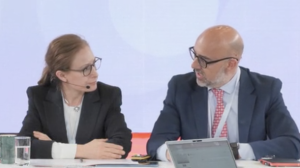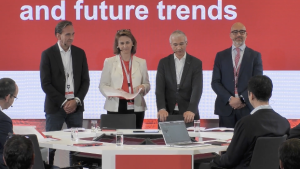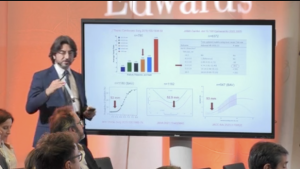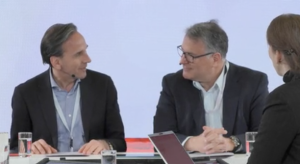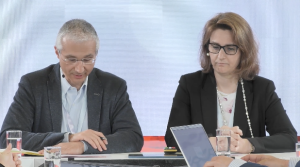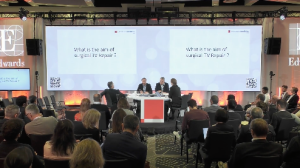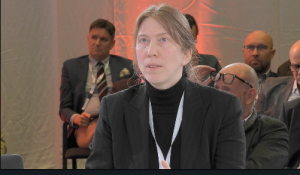
December 8, 2022
 ~5m
~5mGirdauskas E, Pausch J, Eden M, Krane […]
Standardized subannular repair in type IIIb mitral regurgitation: 1-year results from REFORM-MR Registry
Girdauskas E, Pausch J, Eden M, Krane M, Borger M, Walther T, Kuntze T and Falk V.
Presented at 36th European Association for Cardio-Thoracic Surgery Annual Meeting, 2022.
Key points:
- Annuloplasty combined with papillary muscle repositioning to treat type IIIb mitral regurgitation (MR) had acceptable perioperative and 1-year efficacy and safety outcomes.
Background information
- Treating type IIIb MR with annuloplasty alone is associated with a high recurrence rate.
- Combining annuloplasty with subannular repair by papillary muscle repositioning may increase the stability of mitral valve repair in this patient population.
Aims
- To evaluate the safety and efficacy of standardised subannular repair.
Type of study
- A prospective, single-arm, multicentre registry study.
Endpoints
- The primary endpoint was freedom from MR >2+ after 2 years.1
- Secondary endpoints included survival, major adverse cardiac and cerebrovascular events and reinterventions.
Methods
- The study included patients with secondary MR, left ventricular ejection fraction (LVEF) ≤50%, left ventricular end-diastolic diameter (LVEDD) ≥55 mm and tenting of the proximal or anterior mitral leaflets >10 mm.
- Patients underwent annuloplasty (with Carpentier- McCarthy-Adams IMR ETlogix) together with bilateral papillary muscle repositioning.
- Endpoint assessment was performed in echocardiography and magnetic resonance imaging CoreLabs.
Results
Patients
- The study included 94 patients from six centres (Table 1).
Table 1. Baseline characteristics.
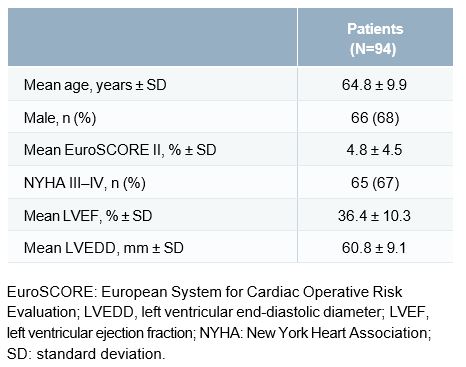
Perioperative outcomes
- The mean cardiopulmonary bypass time was 158 ± 40 min.
- Five patients (5%) developed low cardiac output syndrome and two patients (2%) experienced stroke.
- One patient died during the hospital stay (1.4%).
- At discharge, 43 patients (49%) were free of MR, and 35 (40%) had mild and 9 (10%) moderate residual MR.
Echocardiographic results
- At 1-year, 95.8% of patients were free of MR >2+ (Kaplan-Meir analysis).
- There was improved left ventricular (LV) geometry (remodeling) and reduced tenting parameters at 1-year.
Survival
- The survival rate at 1-year was 95.5%.
Conclusion
Standardised subannular repair by papillary muscle repositioning showed acceptable perioperative and 1-year efficacy and safety outcomes in patients with functional MR, including a low MR >2 recurrence rate.
Improved LV remodeling and tenting parameters were also evident 12 months after surgery. A 2-year follow-up of the study population is currently underway.
References:
- NCT03470155. Available at: https://clinicaltrials.gov/ct2/show/ NCT03470155. [Accessed September 2022].
This document is a summary of the Girdauskas E et al. presentation, as presented at the EACTS congress and covers key information including aim, type of study, methods, results and conclusions.
The full publication is available at:
Abbreviations:

Medical device for professional use. For a listing of indications, contraindications, precautions, warnings, and potential adverse events, please refer to the Instructions for Use (consult eifu.edwards.com where applicable).
Edwards, Edwards Lifesciences, the stylized E logo, Carpentier-McCarthy-Adams IMR ETlogix and IMR ETlogix are trademarks or service marks of Edwards Lifesciences Corporation. All other trademarks are the property of their respective owners.
© 2022 Edwards Lifesciences Corporation. All rights reserved. PP–EU-5310 v1.0
Edwards Lifesciences • Route de l’Etraz 70, 1260 Nyon, Switzerland • edwards.com
Edwards Masters App
Learn anywhere


now fully customized to your needs and interests. Your educational platform
in heart valve surgery.












